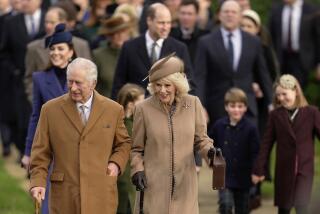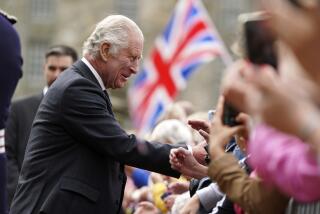Britain Ready to Celebrate Henry VIII’s 500th ‘Bash’ : Monarchy: Historians dispute king’s popular image as a womanizer, despite six marriages.
- Share via
GREENWICH, England — He married six times, beheaded two of his wives, argued with the Pope and indulged a vast appetite for sex, food and jousting.
That is how generations of schoolchildren have remembered King Henry VIII, the larger-than-life English monarch born in this town on the Thames, now a London suburb, 500 years ago on June 28.
Father of Elizabeth I, Mary I and Edward VI, the second king of the Tudor dynasty ruled England from 1509 until his death in 1547.
Birthday festivities this year include frolics in Tudor costume and concerts of period music at stately homes. A hotel in the eastern city of Norwich is even making a special offer to people called Henry or Henrietta for a vacation including feasts of ale, venison and pheasant.
Henry, more than 6 feet tall with an expansive waistline, is commonly seen as a womanizer and as an expert in political intrigue.
But a document in a major new exhibition of life at Henry’s court throws fresh light on the popular image.
“The morning after the first night the Kings Highness lay with the Quene, his Majesty said unto hymn that he had not that night carnally knowne the Quene,” royal physician Dr. Butts wrote of Henry’s first encounter with fourth wife Anne of Cleves.
The king thought Anne a true beauty when shown her portrait, but when he saw her in the flesh he was horrified.
The doctor’s record, later used as evidence for divorce, has been widely known to historians. It is on public display for the first time in the exhibition which opened here this month.
“The second night he lay not with her; the third and fourth night his Grace lay with her and always confessed he could not know her. And so he hath contynually confessed unto the said Dr. Butts to this day.”
“Tudor Thought It!” (who’d have thought it) exclaimed the best-selling tabloid newspaper The Sun. “King Henry VIII was really a FLOP in bed.”
“After the mid-1530s and his third marriage, Henry was virtually impotent, which clashes with films and television programs which always show him as lusty Hal,” The Sun quoted London School of Economics historian David Starkey as saying.
Henry desperately needed a son to continue the Tudor line.
Wife No. 1, Catherine of Aragon, gave him a daughter, Mary. He divorced her, causing a huge rift with the Pope, and married his mistress, Anne Boleyn.
Anne, headstrong and already pregnant when they married, also produced a girl, Elizabeth. Henry quickly tired of her, accused her of adultery and had her beheaded at the Tower of London.
Henry’s only son, Edward--later to become King Edward VI--came from Jane Seymour, but she died soon after the birth. The fifth wife lost her head for flirting with courtiers and the sixth survived. But there were no more children.
Was Henry a pawn of court intrigue, or did his playfulness conceal a thirst for power?
“In some ways, he was really a horrible man,” said Steven Gunn, Modern History Fellow at Merton College, Oxford.
“He was quite prepared to have a close friend executed for merely getting in the way, but he obviously had quite a style. He knew how to cut a figure.”
Henry’s father, Henry VII, came to the throne after defeating Richard III in 1485, ending decades of civil strife in the Wars of the Roses. Henry VIII was haunted by the threat of deposition and affirmed his right to the throne at every turn, Gunn said.
The rift with Rome over his divorce from Catherine of Aragon opened the way for a violent campaign against the Roman Catholic Church.
Hundreds of medieval monasteries were plundered to assert royal supremacy over the church, increasingly corrupt but still a rival for royal power, after the king set himself at the head of the Church of England.
“Henry demolished and dispersed more than any other king in English history,” said Starkey of the London School of Economics. “But he also built and accumulated more.”
The exhibition, “Henry VIII at Greenwich,” is being staged on the site of one of Henry’s palaces and shows him in the mainstream of European Renaissance culture.
It brings together objects from Henry’s collections, including paintings by court artist Hans Holbein, manuscripts of music composed by Henry and treaties exchanged with European leaders.
Years of overindulgence took their toll. Holbein exaggerated Henry’s magnificent shape, elongating his legs in classic portraits. But in later life he became bloated, his eyes reduced to slits and legs covered in fist-size sores. He had to be winched onto his horse to hunt.
Recent research contradicts a common theory that he died of syphilis. More likely, one historian has said, was that lack of Vitamin C gave him scurvy. Citrus fruits were a rarity in 16th-Century England.
More to Read
Sign up for Essential California
The most important California stories and recommendations in your inbox every morning.
You may occasionally receive promotional content from the Los Angeles Times.













